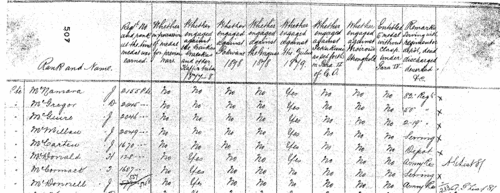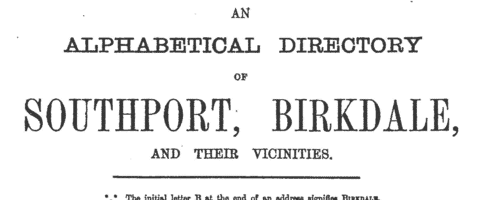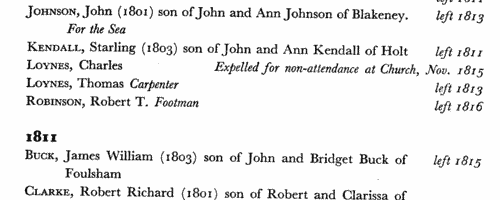Pattenson Surname Ancestry ResultsOur indexes 1000-1999 include entries for the spelling 'pattenson'. In the period you have requested, we have the following 57 records (displaying 51 to 57): Single Surname Subscription | | | Buying all 57 results of this search individually would cost £282.00. But you can have free access to all 57 records for a year, to view, to save and print, for £100. Save £182.00. More... |
These sample scans are from the original record. You will get scans of the full pages or articles where the surname you searched for has been found. Your web browser may prevent the sample windows from opening; in this case please change your browser settings to allow pop-up windows from this site. East Kent Registered Electors: Hope All Saints
(1865)
The poll for two knights of the shire to represent the Eastern Division of the county of Kent in parliament was taken 18 July 1865, the candidates being Sir Edward Cholmeley Dering, bart., (D), Sir Brook William Bridges, bart., (B), and Sir Norton Joseph Knatchbull, bart., (K). This poll book lists all registered electors, whether they voted or not, by electoral district (Ashford, Canterbury, Dover, Faversham, Hythe, Margate, Ramsgate, Romney, Sandwich, Sheerness, Sittingbourne, Whitstable and Wingham) and then by township or parish within which lay the property whereby the electors had qualified. The lefthand column gives sequential number in the whole volume; then follows the elector's full name, surname first, and his address (often elsewhere); and on the righthand side for whom he voted. When the elector was qualified in duplicate the vote is recorded opposite to the number upon which he claimed to vote at the polling booth, and wherever his name occurs elsewhere a reference is made, immediately after the address, to the number where his vote is recorded, with the initials of the candidates for whom he voted. Duplicate voters who were dead at the time of the election, or did not vote, are printed in italics to signify that they did not vote, or are stated to be dead once only; and wherever the names of such electors occur elsewhere references are made to the numbers where alone they are reckoned in the abstract of the poll as dead or not voting. Whenever a number only, without any other reference, follows the address, it denotes that at the number referred to, the elector is entered as not voting. PATTENSON. Cost: £6.00.  | Sample scan, click to enlarge

| Inhabitants of Ceylon (1871)
'The General Directory: of European Residents; Principal Public Servants; and Inhabitants, generally, of Respectable Standing:- including the Secretaries and Principal Clerks in the Various Public and Private Offices; and the Principal Native Headmen, Traders, &c., &c.' corrected up to 16 October 1871, published in A. M. Ferguson's Ceylon Directory.
PATTENSON. Cost: £6.00.  | Sample scan, click to enlarge

|  Men of the 3rd Regiment of Foot (East Kent - the Buffs) fighting in South Africa
(1877-1879) Men of the 3rd Regiment of Foot (East Kent - the Buffs) fighting in South Africa
(1877-1879)
What is commonly called the Zulu War Medal was awarded to those British soldiers who fought in a series of conflicts in southern Africa from 1877 (the Kaffir War) through to 1879 (the Zulu War). In 1880 the various units submitted returns of the officers, non-commissioned officers and men 'entitled to the Medal for Military Operations in South Africa during 1877-8-9' and these 'medal rolls' are now in the National Archives. The returns are made with the information arranged in twelve columns:
1. Rank and name
2. Regimental number and rank at the time the medal was earned
3. Whether in possession of medal for previous wars
4. Whether engaged against the Gaikas, Galekas and other Kaffir tribes 1877-8
5. Whether engaged against Pokwane 1878
6. Whether engaged against the Griquas 1878
7. Whether engaged against the Zulus 1879
8. Whether engaged against Sekukuni as set forth in Par. 2. G. O.
9. Whether engaged against Moirosi's stronghold
10. Entitled to medal without clasp under Par. 4.
11. Serving with regiment, depot, dead, discharged, deserted, &c.
12. Notes and cross-references to the Adjutant-General's medal lists.
WO 100/46.
PATTENSON. Cost: £8.00.  | Sample scan, click to enlarge

| Residents of Ceylon (1880)
The General Directory of Ceylon lists residents alphabetically by surname, with initials, occupation and address. It covers 'European residents, principal public servants, professional classes, and inhabitants, generally, of respectable standing'
PATTENSON. Cost: £8.00.  | Sample scan, click to enlarge

| Residents of Southport, Lancashire
(1883)
Slater's Royal National Directory of Southport and Birkdale with their Vicinities of 1883-4 includes this general alphabetical listing of residents and traders.PATTENSON. Cost: £4.00.  | Sample scan, click to enlarge

| Estates of the Deceased
(1886)
Distribution of the assets of the deceased: giving the names of the deceased and trustees &c. England and WalesPATTENSON. Cost: £6.00.  | Sample scan, click to enlarge

| Boys entering Gresham's School
(1904)
The Sir John Gresham Grammar School at Holt in Norfolk was founded by sir John, who bought the manor house there in 1546 to convert it into a school, and building work had started by 1555. To celebrate the quatercentenary in 1955, a history of the school written by the Reverend C. L. S. Linnell was published, together with an Alumni Greshamienses, a register of boys entering the school from 1562 to 1954, compiled by A. B. Douglas. The materials to hand for the register for the early years were slight; the first coherent lists of boys survive only from 1729, and then are fitful, with little detail, and largely missing from 1784 to 1803; however, from 1810 onwards the names of boys' parents are usually recorded. The register is arranged chronologically by year (and from 1900 by term - L, Lent; M, Michaelmas; S, Summer), and then alphabetically by surname (in capitals) and christian name(s). Where known, year of birth is then given (in brackets), names, addresses and occupations of parents. From 1900 onwards there are italic abbreviations for sporting achievements at school (h, hockey colours; VIII, shooting colours; S, first-class swimmer; XI, cricket colours; XV, football colours), and p for house prefect and P for school prefect; then (in italics) information about the boy's adult life, and his address (where living) at the time of publication. Finally, on the right hand side of the page, in italics, is given the year of his leaving the school. Most detail is absent before 1810; and, of course, for the boys still at school in 1955, or only recently left, there are no details of future career; nor are there the usual details about their parentage. From 1898 onwards day boys are noted with an italic D (N means Newquay dayboy); and from 1900 onwards the school houses are shown (B, Bengal Lodge; F, Farfield; H, School House or Howson's; K, Kenwyn; O, Old School House; W, Woodlands); and, for the junior school, c, Crossways; k, Kenwyn; o, Old School House).PATTENSON. Cost: £4.00.  | Sample scan, click to enlarge

|
Research your ancestry, family history, genealogy and one-name study by direct access to original records and archives indexed by surname.
|










